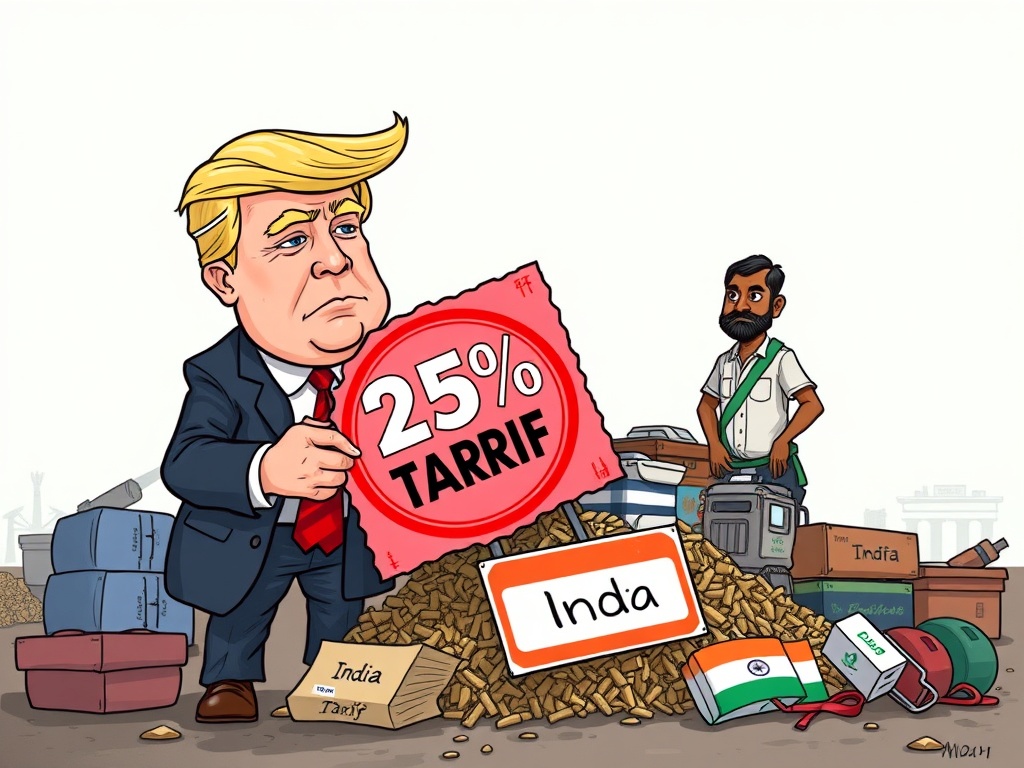BitcoinWorld

Trump Tariffs India: Unveiling the Shockwave of 25% Import Duties
The financial world just received a jolt! Reports from Walter Bloomberg on X indicate that U.S. President Donald Trump has signed an executive order, imposing a significant 25% additional tariff on goods imported from India. This sudden move regarding Trump tariffs India is sending ripples across international markets and raises immediate questions about the future of global commerce. What does this mean for businesses, consumers, and the intricate dance of international relations?
Understanding the Immediate Impact of Trump Tariffs India
This surprising announcement marks a pivotal moment in the bilateral relationship. A 25% levy on various Indian goods entering the U.S. market can significantly alter pricing and competitiveness. Many industries, from textiles to pharmaceuticals, rely heavily on access to the American consumer base. Therefore, this development presents an immediate challenge.
- Increased Costs: Indian exporters will face higher costs, making their products less attractive to U.S. buyers.
- Reduced Demand: U.S. importers may seek alternative, cheaper sources, potentially reducing demand for Indian goods.
- Supply Chain Disruptions: Businesses with established supply chains between the two nations may need to re-evaluate their strategies.
This direct action highlights a growing trend of protectionist measures in the global economy.
What Does This Mean for US India Trade?
The relationship between the United States and India has been complex, often characterized by strategic partnerships alongside trade disagreements. This new imposition of import tariffs on Indian goods could strain these ties further. Historically, both nations have worked towards increasing bilateral trade, which reached significant figures in recent years. This tariff, however, could reverse some of that progress.
Consider the potential ramifications:
- Bilateral Dialogue: It might prompt urgent diplomatic discussions to de-escalate the situation.
- Retaliatory Measures: India could consider imposing its own tariffs on U.S. goods, leading to a tit-for-tat scenario.
- Shift in Focus: Indian exporters might pivot to other markets, seeking new trade agreements to offset losses from the U.S. market.
The trajectory of US India trade now faces a period of uncertainty, demanding careful navigation from policymakers and businesses alike.
Navigating the Waters: The Broader Economic Impact India Could Face
Beyond the immediate trade figures, the ripple effect of these import tariffs could extend throughout the Indian economy. Sectors heavily reliant on exports to the U.S. might experience slowdowns, potentially affecting employment and investment. Small and medium-sized enterprises (SMEs) could be particularly vulnerable, as they often have fewer resources to absorb increased costs or pivot to new markets quickly.
However, every challenge can also present an opportunity. This situation might accelerate India’s push for self-reliance and diversification of its trade partners. It could encourage domestic manufacturing and consumption, reducing reliance on specific export markets. The economic impact India experiences will depend largely on how quickly and effectively the government and businesses adapt to this new trade environment.
Looking Ahead: The Future of Import Tariffs and Global Trade Tensions
This development is not isolated; it fits into a broader pattern of rising global trade tensions. Nations are increasingly using tariffs as tools in economic diplomacy, aiming to protect domestic industries or address perceived imbalances. While such measures aim to benefit domestic sectors, they often lead to higher prices for consumers and reduced overall trade volumes globally.
The imposition of these Trump tariffs India reminds us of the delicate balance in international commerce. Businesses must now become more resilient, agile, and diversified in their operations. Policymakers, on the other hand, face the complex task of balancing national interests with the need for stable and open global trade systems. The coming months will reveal the true extent of these tariffs’ influence and whether they signal a lasting shift in international trade policy.
In conclusion, the announcement of a 25% tariff on Indian imports by former President Trump marks a significant development for US India trade relations. While it presents immediate challenges for Indian exporters and could lead to a broader economic impact India, it also highlights the need for adaptability and diversification in a world of increasing global trade tensions. Staying informed and agile will be crucial for navigating these turbulent waters.
Frequently Asked Questions (FAQs)
Q1: What are the Trump tariffs on Indian imports?
A1: U.S. President Donald Trump signed an executive order imposing an additional 25% tariff on goods imported from India, as reported by Walter Bloomberg on X. This means a 25% tax is added to the cost of these specific Indian products entering the U.S. market.
Q2: Which Indian goods are affected by the 25% tariff?
A2: While the initial report from Walter Bloomberg on X indicates a general 25% tariff on ‘goods imported from India,’ the specific list of affected products would typically be detailed in the executive order itself. Historically, such tariffs have targeted sectors like textiles, agricultural products, or pharmaceuticals.
Q3: How might India respond to these import tariffs?
A3: India could respond in several ways, including diplomatic negotiations to seek a resolution, or by imposing its own retaliatory tariffs on specific U.S. goods. Another strategy could involve accelerating efforts to diversify its export markets and reduce reliance on the U.S.
Q4: What is the potential economic impact on India?
A4: The potential economic impact India faces includes increased costs for exporters, reduced demand for Indian goods in the U.S., and possible disruptions to supply chains. This could lead to slowdowns in export-oriented sectors, affecting employment and investment, especially for smaller businesses.
Q5: How do these tariffs affect US consumers?
A5: For U.S. consumers, these import tariffs could lead to higher prices for goods imported from India. If importers pass on the increased costs, consumers might pay more for certain products, or they may find fewer options as businesses shift away from Indian suppliers.
Did you find this analysis helpful? Share this article with your network to spread awareness about the evolving US India trade landscape and the implications of these significant import tariffs. Your insights can help others understand these crucial economic developments.
To learn more about the latest global trade tensions and their impact on emerging markets, explore our article on key developments shaping international economic policies and future trade relations.
This post Trump Tariffs India: Unveiling the Shockwave of 25% Import Duties first appeared on BitcoinWorld and is written by Editorial Team





